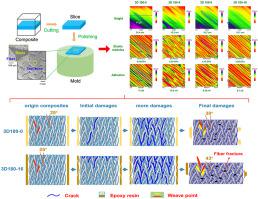Composites Science and Technology ( IF 9.1 ) Pub Date : 2021-09-22 , DOI: 10.1016/j.compscitech.2021.109052 Yuanyuan Wu 1 , Wenjing Cao 1 , Jinhui Guo 1 , Limeng Xun 1 , Baozhong Sun 1 , Bohong Gu 1

|
The macroscopic mechanical behaviors generally correlate with nanomechanical properties, especially elastic modulus. This paper presents the thermo-oxidative ageing effects on nanoscale elastic modulus and impact failure mechanism of 3D braided composites at micro and macro levels using PeakForce Quantitative Nano-Mechanics (PF-QNM) and digital image correlation (DIC) technologies. The values of nanoscale elastic modulus of near-fiber resin pocket were about three times than that of global modulus in neat resin under low-velocity impact compression (LVIC) loading. However, the modulus retention rates were consistent which was ∼88% after ageing for 16 days at 180 °C. The decline of them has provided a direct evidence for resin degradation after ageing. In addition, the in-plane impact failure mechanism of braided composites mainly contained five modes, i.e., matrix cracking, interface cracking, matrix fracture and peeling off, fiber buckling and slipping, and fiber breakage. Thermo-oxidative ageing only changed the crack propagation path but not the damage modes.
中文翻译:

热氧化环境下3D编织复合材料的近纤维纳米力学映射和冲击失效机制
宏观力学行为通常与纳米力学性能相关,尤其是弹性模量。本文使用 PeakForce 定量纳米力学 (PF-QNM) 和数字图像相关 (DIC) 技术,在微观和宏观层面介绍了热氧化老化对 3D 编织复合材料的纳米级弹性模量和冲击破坏机制的影响。在低速冲击压缩 (LVIC) 载荷下,近纤维树脂袋的纳米级弹性模量值约为纯树脂整体模量的三倍。然而,模量保持率是一致的,在 180°C 下老化 16 天后约为 88%。它们的下降为树脂老化后降解提供了直接证据。此外,编织复合材料的面内冲击破坏机制主要有基体开裂、界面开裂、基体断裂与剥落、纤维屈曲滑移、纤维断裂五种模式。热氧化时效只改变了裂纹扩展路径,而没有改变损伤模式。


























 京公网安备 11010802027423号
京公网安备 11010802027423号